Are you getting enough protein? This article highlights the benefits of protein, top protein foods, and includes a high protein foods chart with a printable PDF curated by a Registered Dietitian Nutritionist.
If you buy from one of the links in this post, I may earn a commission. Visit my Privacy Policy for more information on affiliates.
What is protein?
Protein is a macronutrient. Macronutrients are the nutrients that you need in your diet in the largest amounts. Hence the beginning of the word: “macro”.
The other macronutrients include carbohydrates and fat.
Every food that you eat is made up of a combination of these. Each plays many critical roles in your body.
Amino acids make up the building blocks of protein. Combinations of the 20+ essential amino acids contribute to every cell in the body. This includes the cells that makeup your organs, skin, bones, muscle, hair, etc. Everything!
Benefits of protein
- Helps you feel full and satisfied longer. This may help support weight loss or weight management goals.
- Regulates blood sugar levels.
- Builds and maintains the body’s cells.
- Maintains cognitive function. Protein helps to create the neurotransmitters in the brain. These help communicate messages from your brain to the rest of your body. Some neurotransmitters include serotonin and dopamine. Studies suggest that ADHD could be linked to a deficiency or dysfunction in dopamine. So protein may be of particular importance for those with ADHD and those looking to support their mental health.
- Plays a part in a healthy immune system.
- Maintains muscle mass.
- Helps with recovery following exercise, injury, surgery, or infection.
- Supports a healthy pregnancy. Protein helps pregnant people meet the increased demands for blood volume, amniotic fluid and the rapid growth of the placenta and baby.
So, in short: it’s very important.
How much protein do I need a day?
Healthy adults need about 0.8 grams of protein per kilogram of bodyweight per day.
Nutritional needs vary based on a number of factors. These include height, weight, and physical activity.
This amount increases for individuals who are pregnant, recovering from physical activity, injury, surgery or infection.
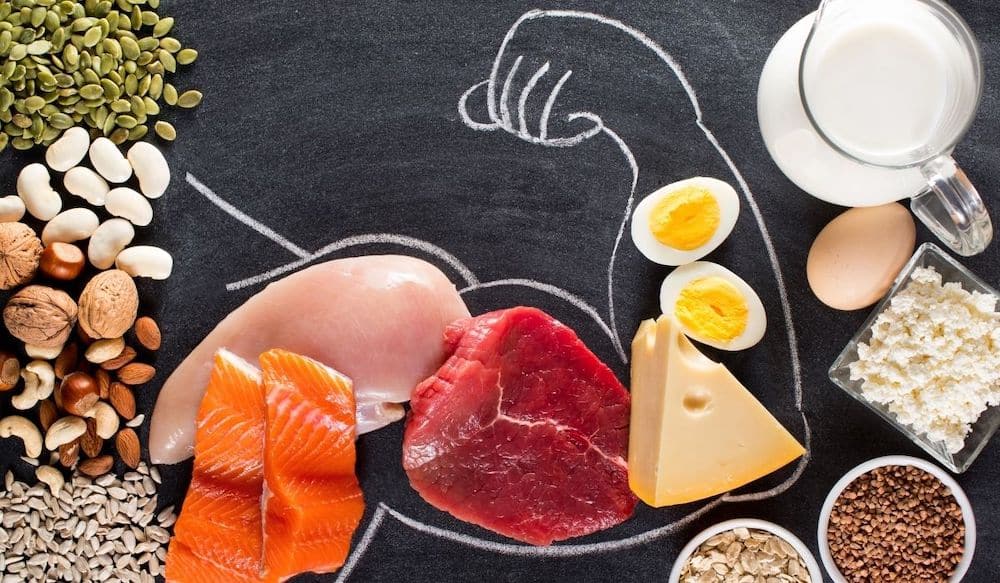
How do I calculate how much protein I need?
Example calculation for a healthy adult:
0.8g x weight in kg = grams of protein per day
0.8g x 75 kg = 60 g of protein/day
What is considered a high protein diet?
A typical healthy diet contains anywhere from 10-35% of calories from protein.
A high protein diet is often considered to be one that contains 20% or more of its calories from protein.
Therefore, a high protein food is usually one that contains 20% or more of its calories from protein.
Of course, people will have different ideas of what they consider high protein. Different countries even have different labeling standards when it comes to what can be labeled “high protein” on food products.
So, the definition may vary based on who you ask.
The high protein foods list below does contain some foods with less than 20% protein. This was done to show you the difference between certain types of protein sources.
For instance, the difference between the protein content of soy milk and almond milk might surprise you.
Best sources of protein
Those who follow a high protein diet may include additional protein in their diets in many different ways. However, some are better sources of protein than others.
What are the top 10 best protein foods?
- Lean meats
- Poultry
- Eggs
- Dairy
- Fish
- Legumes, such as beans, peas and lentils
- Tofu
- Nuts and nut butters
- Seeds
- Some whole grains
Grain products tend to be lower in protein. Whereas, fruits and vegetables often have no protein.
Not all protein sources include all 20+ essential amino acids. For this reason a variety of protein foods is recommended to ensure optimal protein intake.
High protein foods chart
Below is your high protein food list – with a free download and printable PDF version at the end of this article.
All foods listed will have a combination of protein, carbohydrates, and healthy fats. I have only included the portion sizes, grams of protein, and caloric value for simplicity.
All values are based on the Canadian Nutrient File and the FoodData Central database, unless otherwise indicated.
The values are averages and will vary depending on the product. Check the nutrition facts label on the foods you consume for more accurate numbers.
This list includes common foods. If there are any other foods that you would like me to add to this list, please leave a comment at the end of this article!
Protein Content of Foods Chart
| Meat, poultry, & eggs | |||
| Food | Portion size | Protein amount (g) | Calories (kcal) |
| Chicken breast | 75 g | 25 | 119 |
| Turkey, roasted | 75 g | 21 | 116 |
| Beef, steak | 75 g | 20 | 230 |
| Beef, lean ground | 75 g | 22 | 194 |
| Hamburger | 90 g patty | 12 | 275 |
| Beef jerky | 20 g | 7 | 81 |
| Pork tenderloin | 75 g | 21 | 108 |
| Pork, lean ground | 75 g | 19 | 175 |
| Ham, cured | 75 g | 17 | 124 |
| Lamb, shank | 75 g | 21 | 182 |
| Egg | 1 egg, large | 6 | 78 |
| Egg whites | From 1 egg, large | 3 | 16 |
| Seafood | |||
| Food | Portion size | Protein amount (g) | Calories (kcal) |
| Salmon, baked | 75 g | 17 | 155 |
| Salmon, pink canned | 75 g | 17 | 102 |
| Rainbow trout | 75 g | 18 | 127 |
| Tuna, light canned | 75 g | 19 | 87 |
| Sardines, canned in oil and drained | 106 g can | 26 | 220 |
| Shrimp | 30 g, 6 medium | 6 | 30 |
| Lobster | 77 g | 16 | 75 |
| Scallops | 78 g, 6 medium | 18 | 87 |
| Imitation crab meat | 67 g | 8 | 68 |
| Dairy | |||
| Food | Portion size | Protein amount (g) | Calories (kcal) |
| Milk, skim | 250 mL | 9 | 88 |
| Milk, 1% | 250 mL | 9 | 108 |
| Milk, 2% | 250 mL | 9 | 129 |
| Milk, whole | 250 mL | 8 | 155 |
| Nonfat yogurt | 175 mL | 8 | 79 |
| Greek yogurt, plain, 8-12% | 175 mL | 12 | 314 |
| Kefir | 175 mL | 6 | 104 |
| Sour cream, 5% | 15 mL | 1 | 21 |
| Cottage cheese, 1% | 125 mL | 15 | 86 |
| Cream cheese, regular | 30 mL | 2 | 103 |
| Ricotta cheese | 125 mL | 15 | 181 |
| Cheddar cheese | 50 g | 12 | 202 |
| Feta | 50 g | 7 | 132 |
| Parmesan, grated | 15 mL | 2 | 27 |
| Plant-based foods | |||
| Food | Portion size | Protein amount (g) | Calories (kcal) |
| Tofu, firm | 150 g | 21 | 189 |
| Tofu, soft | 150 g | 7 | 83 |
| Tempeh | 150 g | 27 | 296 |
| Peanuts | 60 mL | 9 | 217 |
| Walnuts | 60 mL | 4 | 166 |
| Cashews | 60 mL | 5 | 199 |
| Almonds | 60 mL | 8 | 208 |
| Pistachios | 60 mL | 7 | 177 |
| Hazelnuts | 60 mL | 5 | 215 |
| Brazil nuts | 60 mL | 5 | 233 |
| Pine nuts | 60 mL | 5 | 230 |
| Sunflower seeds | 60 mL | 6 | 189 |
| Flax seeds | 30 mL | 4 | 112 |
| Chia seeds | 30 mL | 4 | 106 |
| Hemp hearts | 30 mL | 7 | 118 |
| Pumpkin seeds | 60 mL | 9 | 189 |
| Peanut butter, natural | 30 mL | 7 | 184 |
| Almond butter | 30 mL | 5 | 205 |
| Tahini | 30 mL | 5 | 181 |
| Black beans | 175 mL | 11 | 162 |
| Red kidney beans | 175 mL | 10 | 161 |
| Navy beans | 175 mL | 15 | 219 |
| Soy beans | 175 mL | 21 | 220 |
| Pinto beans | 175 mL | 9 | 153 |
| Fava beans | 175 mL | 10 | 134 |
| Refried beans | 175 mL | 10 | 175 |
| Black eyed peas | 175 mL | 8 | 135 |
| Lentils | 175 mL | 13 | 170 |
| Lima beans | 125 mL | 6 | 100 |
| Green peas | 125 mL | 4 | 66 |
| Edamame | 125 mL | 9 | 100 |
| Chickpeas | 175 mL | 9 | 211 |
| Hummus | 60 mL | 4 | 94 |
| Falafel | 1 ball or 17 g | 2 | 57 |
| Quinoa | 125 mL | 2 | 70 |
| Oats | 175 mL | 4 | 99 |
| Cream of wheat | 175 mL | 2 | 46 |
| Rice, white | 125 mL | 2 | 109 |
| Rice, brown | 125 mL | 3 | 115 |
| Barley | 125 mL | 2 | 102 |
| Couscous | 125 mL | 3 | 93 |
| Popcorn, airpoped | 500 mL | 2 | 65 |
| Dry cereal, Bran Flakes | 250 mL | 5 | 185 |
| Egg noodles | 250 mL | 8 | 225 |
| Pasta, white | 250 mL | 7 | 209 |
| Pasta, whole wheat | 250 mL | 8 | 183 |
| Bread, whole wheat | 1 slice | 3 | 86 |
| Bagel, plain | 1 bagel | 7 | 195 |
| Naan | ½ slice | 7 | 192 |
| Pita, white | 1 pita | 5 | 165 |
| Tortilla, wheat | 20cm tortilla | 4 | 159 |
| Asparagus | 6 spears | 2 | 18 |
| Avocado | ½ avocado | 2 | 161 |
| Beets | 125 mL | 2 | 40 |
| Broccoli | 125 mL | 3 | 27 |
| Brussel sprouts | 4 sprouts | 3 | 33 |
| Spinach | 125 mL | 3 | 22 |
| Plant-based beverages (values from Silk) | |||
| Food | Portion size | Protein amount (g) | Calories (kcal) |
| Almond milk, unsweetened | 250 mL | 1 | 40 |
| Oat milk, unsweetened | 250 mL | 1 | 70 |
| Soy milk, unsweetened | 250 mL | 7 | 85 |
| Protein powders | |||
| Food | Portion size | Protein amount (g) | Calories (kcal) |
| Whey protein powder | 50 g, ~1 large scoop | 39 | 176 |
| Plant-based protein powder | 50 g, ~1 large scoop | 28 | 194 |
Download this high protein foods chart in PDF format.
It’s a great resource to refer to if looking to increase the protein in your diet. You can post it on your fridge, use it to help with meal planning, and/or bring it with you to the grocery store.
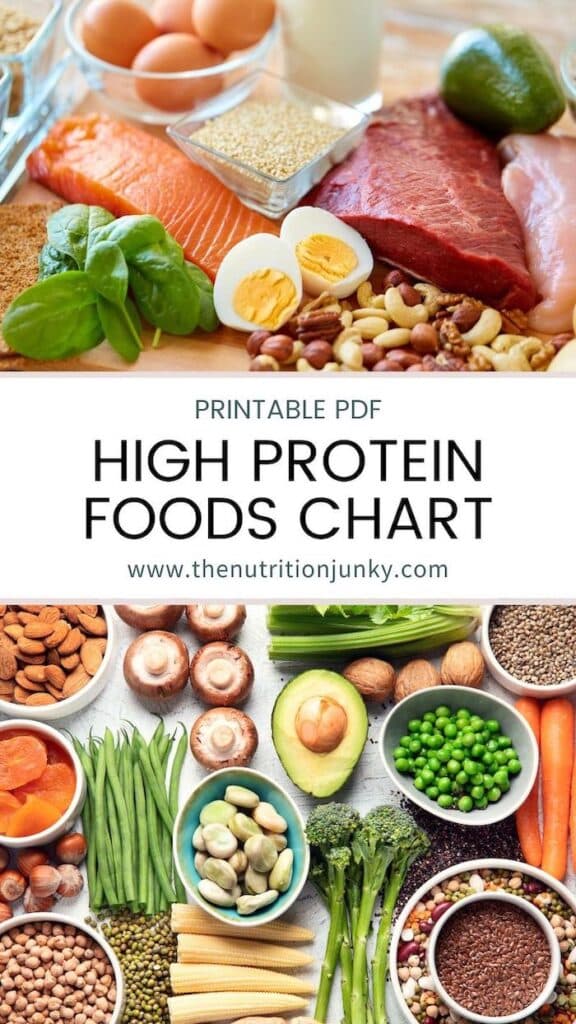
Bottom line
- Protein is a macronutrient needed by the body.
- The benefits of protein include keeping you full longer, regulating blood sugar, helping with recovery and maintaining the body’s cells, as well as cognitive function, immune system, and muscle mass.
- The amount of protein that you need a day depends on your height, weight, and activity levels.
- The best protein sources include lean meats, poultry, eggs, dairy, fish, legumes, tofu, nuts, seeds, and some whole grains.
- A variety of protein sources is best for overall health and in maintaining a healthy lifestyle.
Did you enjoy this article & high protein foods chart? Please comment below!
If you want to read more, check out my article on Meal Replacement Shakes vs Protein Shakes or my article on the ADHD Diet.

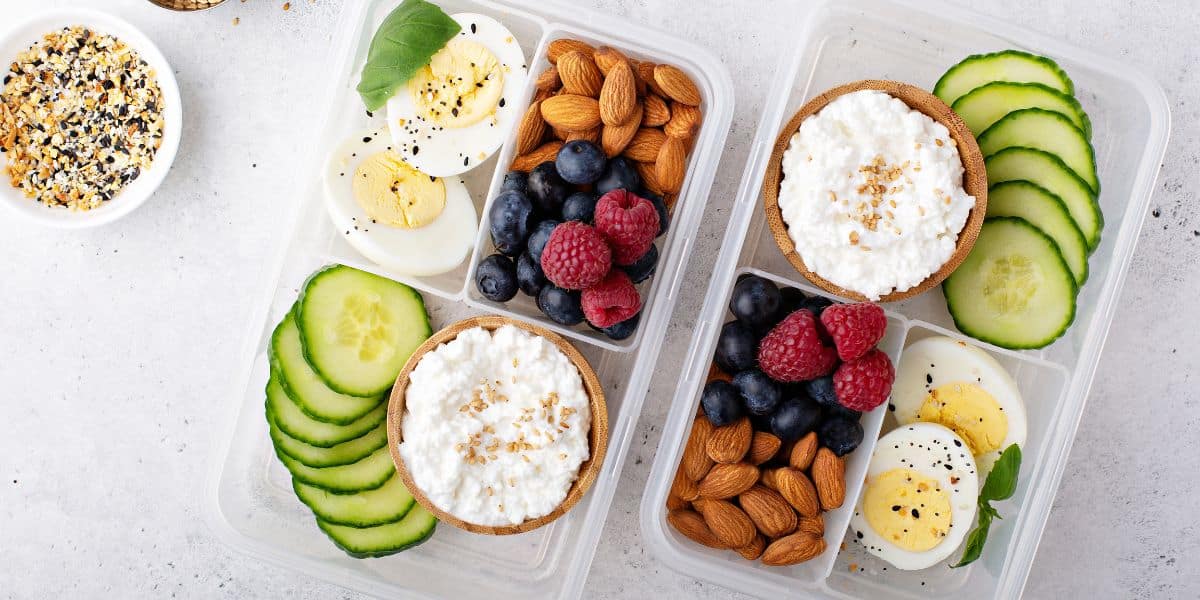
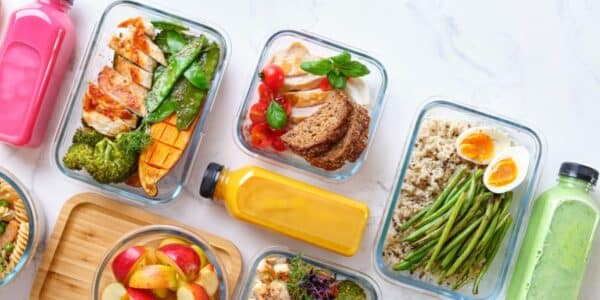

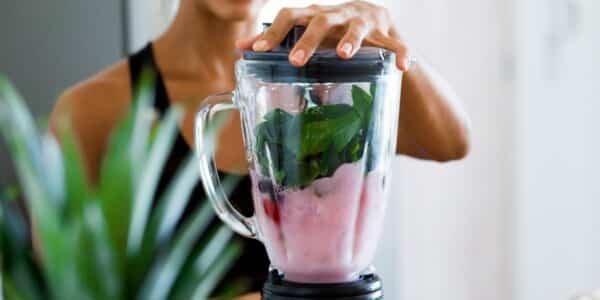

I was googling for content about High-Protein Vegetables When I came across your excellent resource page.
I just wanted to say that your page helped me.
Thanks for putting together your list of resources. Have a great day.